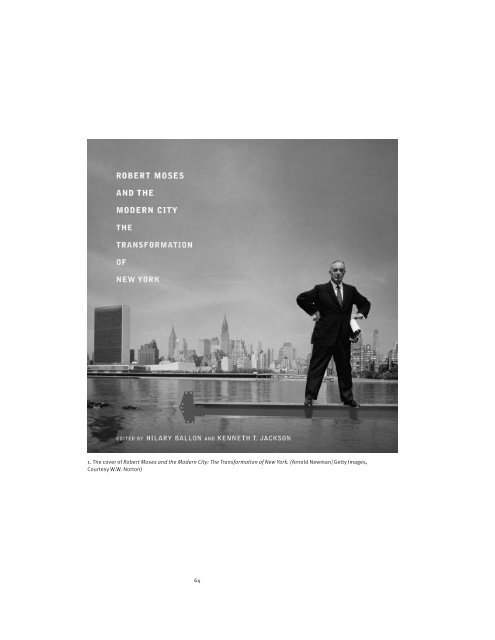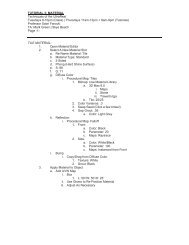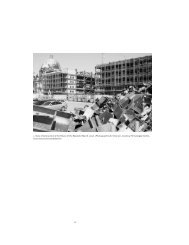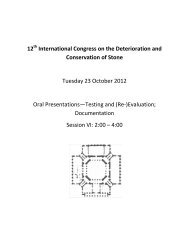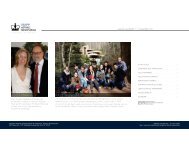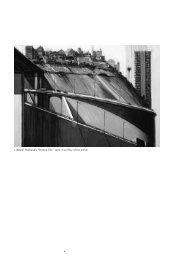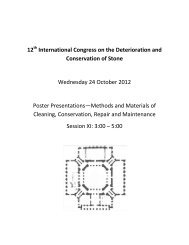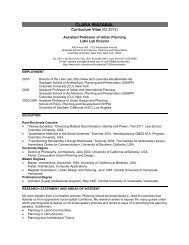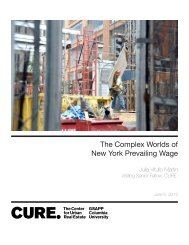Exhibition Review: Robert Moses and the Modern City - Columbia ...
Exhibition Review: Robert Moses and the Modern City - Columbia ...
Exhibition Review: Robert Moses and the Modern City - Columbia ...
You also want an ePaper? Increase the reach of your titles
YUMPU automatically turns print PDFs into web optimized ePapers that Google loves.
1. The cover of <strong>Robert</strong> <strong>Moses</strong> <strong>and</strong> <strong>the</strong> <strong>Modern</strong> <strong>City</strong>: The Transformation of New York. (Arnold Newman/Getty Images,<br />
Courtesy W.W. Norton)<br />
64
<strong>Exhibition</strong> <strong>Review</strong><br />
R<strong>and</strong>all F. Mason<br />
Future Anterior<br />
Volume IV, Number 1<br />
Summer 2007<br />
<strong>Robert</strong> <strong>Moses</strong> <strong>and</strong> <strong>the</strong> <strong>Modern</strong> <strong>City</strong><br />
<strong>Columbia</strong> University historians Hilary Ballon <strong>and</strong> Kenneth<br />
Jackson <strong>and</strong> <strong>the</strong>ir colleagues deserve high praise. Their revisionist<br />
project, which documents <strong>and</strong> debates <strong>Robert</strong> <strong>Moses</strong>,<br />
is characterized by superb scholarship spread across three<br />
museum exhibits, a website, lectures, panels, <strong>and</strong> a catalogue,<br />
<strong>Robert</strong> <strong>Moses</strong> <strong>and</strong> <strong>the</strong> <strong>Modern</strong> <strong>City</strong>: The Transformation<br />
of New York. The three exhibits are “<strong>Robert</strong> <strong>Moses</strong> <strong>and</strong> <strong>the</strong><br />
<strong>Modern</strong> <strong>City</strong>: Slum Clearance <strong>and</strong> <strong>the</strong> Superblock Solution” at<br />
<strong>the</strong> Miriam & Ira D. Wallach Art Gallery at <strong>Columbia</strong> University;<br />
“<strong>Robert</strong> <strong>Moses</strong> <strong>and</strong> <strong>the</strong> <strong>Modern</strong> <strong>City</strong>: The Road to Recreation”<br />
at <strong>the</strong> Queens Museum of Art; <strong>and</strong> “<strong>Robert</strong> <strong>Moses</strong> <strong>and</strong> <strong>the</strong><br />
<strong>Modern</strong> <strong>City</strong>” at <strong>the</strong> Museum of <strong>the</strong> <strong>City</strong> of New York.<br />
This season of <strong>Moses</strong> confirms that he left a wonderful<br />
legacy—dozens of places of lasting public value. The exhibits<br />
<strong>and</strong> catalogue will be acknowledged as essential material for<br />
<strong>the</strong> education of planners, urban designers, politicians <strong>and</strong><br />
urbanists of all stripes. <strong>Moses</strong> had enormous effect on <strong>the</strong><br />
New York materially (<strong>the</strong> buildings <strong>and</strong> l<strong>and</strong>scapes), politically<br />
(empire building, bullying, alienating “<strong>the</strong> people”), <strong>and</strong><br />
culturally (we are still talking about him, due to <strong>Robert</strong> Caro’s<br />
The Power Broker as well as <strong>the</strong> current exhibits). 1 In all <strong>the</strong>se<br />
senses, <strong>Moses</strong>’ legacy is obvious <strong>and</strong> extensive.<br />
But <strong>the</strong> discussion surrounding his character—cast in<br />
<strong>the</strong> formulation “Was he a good or a bad man?”—is a red herring.<br />
The serious question ventured by <strong>the</strong> exhibits is what we<br />
should remember <strong>and</strong> learn from <strong>Moses</strong>, his built works, <strong>and</strong><br />
his political agility. Or, taking <strong>the</strong> current exhibits <strong>and</strong> scholarship<br />
on <strong>the</strong>ir own ground, how should <strong>Moses</strong> be remembered?<br />
The assembled scholars behind this project recognize <strong>Moses</strong>’<br />
incredible legacy without bowing before it. The legacy is h<strong>and</strong>led<br />
evenh<strong>and</strong>edly, though <strong>the</strong> balance sheet is positive, a<br />
different <strong>and</strong> welcome take from Caro’s until-now canonical view.<br />
Each school of thought, though, is a sign of its time. Caro<br />
wrote in <strong>the</strong> aftermath of <strong>the</strong> denouement of <strong>Moses</strong>’ downfall,<br />
with <strong>the</strong> cynicism it rightly engendered about powerful government<br />
agency. Ballon, Jackson, <strong>and</strong> <strong>the</strong>ir collaborators write in<br />
a period of renewed confidence about public-sector building<br />
<strong>and</strong> acceptance of community will as part of <strong>the</strong> city-building game.<br />
Apart from <strong>Moses</strong>’ legacy, one would expect <strong>the</strong>se eminent<br />
historians to dwell on <strong>Moses</strong>’ own history. Yet little<br />
interest is shown in where <strong>Moses</strong> came from, what legacies<br />
65
he inherited, on whose shoulders he stood—on what came<br />
“before <strong>Moses</strong>” <strong>and</strong> enabled his full flowering. The exhibits<br />
convey <strong>the</strong> message that <strong>Moses</strong> sprang, fully formed—brilliant<br />
though flawed—to his perch on <strong>the</strong> steel beam comm<strong>and</strong>ing<br />
<strong>the</strong> city. (Figure 1)<br />
The Exhibits<br />
The three complementary exhibits are impressive in scope <strong>and</strong><br />
scale. They document <strong>the</strong> vast reach of <strong>Moses</strong>’ influence by<br />
showcasing his projects: roads, parks, pools, housing complexes,<br />
urban renewal schemes. The Wallach Gallery focuses<br />
on <strong>the</strong> clearance <strong>and</strong> modernist design of urban renewal<br />
schemes; <strong>the</strong> Museum of <strong>the</strong> <strong>City</strong> of New York on roads,<br />
bridges <strong>and</strong> parks; <strong>and</strong> <strong>the</strong> Queen Museum of Art on recreational<br />
projects such as beaches, pools, <strong>and</strong> playgrounds. The<br />
ensemble of <strong>Moses</strong>’ works definitively transformed New York<br />
from a walking <strong>and</strong> transit city into <strong>the</strong> automobile metropolis<br />
of today. They created a sense of mobility fueling a metropolitan<br />
sense of <strong>the</strong> region while infusing dense <strong>and</strong> rebuilt neighborhoods<br />
with park infrastructure.<br />
The design of <strong>the</strong> exhibits varies in quality <strong>and</strong> effectiveness,<br />
ranging from <strong>the</strong> simple, careful, <strong>and</strong> surprisingly lovely<br />
display of original documents at <strong>Columbia</strong>, to <strong>the</strong> hastily<br />
constructed <strong>and</strong> cheap Museum of <strong>the</strong> <strong>City</strong> of New York installations.<br />
The organization <strong>and</strong> design of <strong>the</strong> vast exhibit at <strong>the</strong><br />
Queens Museum is particularly clear, affording <strong>the</strong> space for<br />
inspection as well as reflection on <strong>the</strong> many historical photographs<br />
<strong>and</strong> graphics. Andrew Moore’s large-format color<br />
photographs, parceled across <strong>the</strong> three exhibits, match <strong>the</strong><br />
clarity <strong>and</strong> power of <strong>Moses</strong>’ vision, though without hubris. The<br />
photographs document <strong>the</strong> quality design as well as <strong>the</strong> contemporary<br />
social values <strong>the</strong> places continue to nurture—more<br />
than pretty pictures of good design, <strong>the</strong>y capture people using<br />
<strong>the</strong> places, such as kids swimming at <strong>the</strong> well-loved pools.<br />
The dozens of projects shown in <strong>the</strong> exhibits are best<br />
described as muscular. Many of <strong>the</strong>m asserted modernism as<br />
a new <strong>and</strong> confident language for public works, particularly<br />
<strong>the</strong> pools <strong>and</strong> housing towers by some of <strong>the</strong> leading midtwentieth-century<br />
architects including I.M. Pei <strong>and</strong> Wallace<br />
Harrison. Each required massive amounts of labor, material<br />
<strong>and</strong> dollars; <strong>the</strong> bridges <strong>and</strong> highways transcended <strong>the</strong><br />
natural <strong>and</strong> human geography of region, crossing rivers <strong>and</strong><br />
clearing neighborhoods. <strong>Moses</strong>’ projects—<strong>and</strong> <strong>the</strong>ir shaping<br />
of New York’s l<strong>and</strong>scape—were all business, even when <strong>the</strong>y<br />
were really about play. But many were also beautiful, including<br />
some projects never completed: what fan of mid-century<br />
modernism doesn’t secretly wish that an unbuilt Edward Durell<br />
Stone pavilion were presently st<strong>and</strong>ing in Central Park?<br />
66
2. Title I Slum Clearance Progress,<br />
April 16, 1956. (Avery Library Archives,<br />
Courtesy W.W. Norton)<br />
<strong>Moses</strong> understood <strong>the</strong> power of visual communication<br />
through models, brochures, <strong>and</strong> constant press attention.<br />
The exhibits build upon <strong>Moses</strong>’ own propag<strong>and</strong>a to make <strong>the</strong><br />
visual argument for <strong>Moses</strong>’ historical significance extremely<br />
well, though a sense of <strong>the</strong> historical narrative is left for <strong>the</strong><br />
catalogue, which is an essential companion to <strong>the</strong> exhibits.<br />
(Figure 2)<br />
While <strong>the</strong> urbanistic expression of <strong>Moses</strong>’ work is<br />
brilliantly displayed, a correspondingly thorough account<br />
of <strong>Moses</strong>’ political works is missing from <strong>the</strong> exhibits. The<br />
administrative architectures he employed, his boldness<br />
in deploying <strong>the</strong>m, <strong>and</strong> his personal political skills are not<br />
conveyed. Likewise, only a weak sense of <strong>the</strong> community<br />
opposition, so important to shaping our memory of <strong>Moses</strong>,<br />
is included. The narratives are <strong>the</strong>re—regarding Washington<br />
Square Park, for example—but <strong>the</strong> opposition tends to get<br />
lost, or cartooned, in <strong>the</strong> exhibits. Politics <strong>and</strong> community<br />
opposition usually are not as visually interesting as master<br />
building, so perhaps <strong>the</strong>re is little surprise that <strong>the</strong> exhibits<br />
are weaker on this topic.<br />
67
The Catalogue<br />
Ballon <strong>and</strong> Jackson’s catalogue is superb in every regard, <strong>and</strong><br />
spares <strong>the</strong> exhibits from most weaknesses <strong>and</strong> elisions. The<br />
book’s portfolio of photographs, drawings <strong>and</strong> o<strong>the</strong>r graphics<br />
from <strong>the</strong> exhibit, with accompanying dossiers <strong>and</strong> capsule histories<br />
of individual projects, gives one <strong>the</strong> take-home exhibit.<br />
And it collects a set of rich, clear, <strong>and</strong> relatively brief essays<br />
by leading scholars, who use <strong>Moses</strong> as an axis to spin out <strong>the</strong><br />
contexts in which he operated—<strong>the</strong>y don’t fetishize Big Bob<br />
<strong>the</strong> Builder, while remaining centered on his successes <strong>and</strong><br />
failures. 2 The authors match <strong>Moses</strong>’ muscular legacy of public<br />
works with <strong>the</strong>ir own forceful <strong>and</strong> carefully researched analyses.<br />
They rebuild <strong>Moses</strong>’ story with balance <strong>and</strong> depth, restoring<br />
what was lost in Caro’s enthusiastic but cynical reconstruction.<br />
Jackson begins by presenting <strong>the</strong> argument for revisiting<br />
Caro’s interpretation of <strong>Moses</strong>. It is even-h<strong>and</strong>ed, <strong>and</strong><br />
puts <strong>Moses</strong>’ entire mid-century moment in historical context.<br />
Owen Gutfreund’s essay does <strong>the</strong> best job of giving <strong>Moses</strong><br />
a history before his moment, emphasizing, for instance, <strong>the</strong><br />
design precedents <strong>Moses</strong> copied (<strong>the</strong> Bronx River Parkway, for<br />
instance) <strong>and</strong> <strong>the</strong> public benefit corporation model of administration<br />
he adapted. Built on <strong>the</strong> historical <strong>and</strong> contemporary<br />
contexts out of which <strong>the</strong> master builder emerged, Gutfreund<br />
concludes, “<strong>Moses</strong> was <strong>the</strong> right person in <strong>the</strong> right place at<br />
<strong>the</strong> right time. He did not invent a vision of a novel New York<br />
from whole cloth, but instead he deftly appropriated innovations<br />
<strong>and</strong> plans of o<strong>the</strong>rs, adapting <strong>and</strong> combining <strong>the</strong>m to<br />
suit his purposes <strong>and</strong> <strong>the</strong>n readapting <strong>the</strong>m as circumstances<br />
changed.” 3 Or, as Jackson puts it: “What made [<strong>Moses</strong>] unusual<br />
was not <strong>the</strong> originality of his thought but <strong>the</strong> personal qualities<br />
that allowed him to build where o<strong>the</strong>r could only dream.<br />
<strong>Moses</strong> <strong>the</strong> visionary was second rate; <strong>Moses</strong> <strong>the</strong> builder was<br />
in a class by himself.” 4<br />
The ever-present reality of racial discrimination, not just<br />
in <strong>Moses</strong>’ psyche but also as a social structure of <strong>the</strong> period, is<br />
prominently included in Martha Biondi’s essay. Marta Gutman<br />
takes up one set of <strong>Moses</strong>’ vast works—recreational projects<br />
such as pools <strong>and</strong> beaches <strong>and</strong> playgrounds—sensitively, considering<br />
race <strong>and</strong> how it should shape our memory of <strong>Moses</strong>.<br />
Joel Schwartz’s posthumous thoughts couch <strong>Moses</strong> thoughtfully<br />
in <strong>the</strong> history of efforts to plan New York in <strong>the</strong> first half of<br />
<strong>the</strong> twentieth century.<br />
<strong>Robert</strong> Fishman’s persuasive essay highlights Washington<br />
Square Park (Figures 3 <strong>and</strong> 4) as a watershed conflict not just<br />
in <strong>Moses</strong>’ career but in American urbanism—marking <strong>the</strong><br />
arrival of community voices <strong>and</strong> grassroots participation as<br />
new, transformative partners in <strong>the</strong> urban process. Like his<br />
colleagues in <strong>the</strong> book, Fishman draws compelling evidence<br />
68
3. Comparative plans of Washington<br />
Square Park with <strong>Moses</strong>’ proposed<br />
alterations on <strong>the</strong> right. (New York<br />
Times, Mar. 11, 1955, Courtesy W.W.<br />
Norton)<br />
from <strong>the</strong> archives, unfolding <strong>the</strong> scenes in which <strong>the</strong> politics of<br />
<strong>the</strong> day, <strong>and</strong> <strong>Moses</strong>’ politicking, play out as a game, a game in<br />
which <strong>Moses</strong> begins his career-ending losing streak.<br />
These essays work toge<strong>the</strong>r to create a masterful analysis<br />
of <strong>Moses</strong>’ moment. But from where did this moment come?<br />
The historians should be stronger on this <strong>the</strong>me. <strong>Moses</strong> <strong>and</strong><br />
his opponents, <strong>and</strong> <strong>the</strong> resources he used did not appear<br />
all at once in <strong>the</strong> 1930s. They emerged out of decades of <strong>the</strong><br />
city’s development, on <strong>the</strong> efforts of countless reformers,<br />
visionaries, <strong>and</strong> designers, <strong>and</strong> from contingencies quite<br />
outside of <strong>Moses</strong>’ control. The historians let <strong>Moses</strong>’ giant<br />
shadow obscure <strong>the</strong>se important precedents <strong>and</strong> foundations.<br />
Gutfreund touches <strong>the</strong>se bases <strong>the</strong> best, <strong>and</strong> most of <strong>the</strong> o<strong>the</strong>r<br />
chapters build some sense historical precedent, but <strong>the</strong> exhibits<br />
fail to communicate this, <strong>and</strong> leave <strong>the</strong> giant exposed—in<br />
his glory <strong>and</strong> infamy—but without enough historical narrative<br />
or context to underst<strong>and</strong> <strong>the</strong> origin of <strong>Moses</strong> <strong>and</strong> his moment.<br />
Myths <strong>and</strong> Legacies<br />
There is romanticizing on all sides of <strong>the</strong> <strong>Moses</strong> debates: celebrators<br />
picture <strong>the</strong> figure on <strong>the</strong> cover of <strong>the</strong> book—virile, in<br />
charge, a force of nature, damning those who dared to st<strong>and</strong><br />
in his way; detractors find an easy villain. All of which leaves<br />
69
4. Hulan Jack’s revised proposal of<br />
a roadway in Washington Square<br />
Park. (New York Times, May 18, 1957,<br />
Courtesy W.W. Norton)<br />
a great deal of important history <strong>and</strong> urbanism unrecognized,<br />
or worse, obscured. The exhibits perpetuate <strong>the</strong> myth that<br />
only big, new construction projects are worthy of historians’<br />
attention <strong>and</strong> of public notice, though <strong>the</strong> catalogue’s essays<br />
give <strong>the</strong> reader many reasons to doubt <strong>the</strong> myth. The romantic<br />
Janus-like figure of <strong>Moses</strong> <strong>the</strong> Villain–<strong>Moses</strong> <strong>the</strong> Hero blots<br />
out important narratives about building New York that are<br />
worth remembering <strong>the</strong>mselves.<br />
The exhibits have little to suggest <strong>the</strong> <strong>Moses</strong> evolved<br />
out of any tradition or that he built upon foundations laid by<br />
o<strong>the</strong>rs. But he did not spring, fully formed, upon <strong>the</strong> scene in<br />
1934. And his design ideas as well as political strategies owed<br />
great debts to those who preceded him. Quasi-governmental<br />
commissions (also called public benefit corporations) created<br />
<strong>the</strong> political space <strong>Moses</strong> later occupied so brilliantly with<br />
<strong>the</strong> largesse of federal funds he amassed. The commissions<br />
responsible for Central Park, preservation of <strong>the</strong> Palisades,<br />
reform of <strong>the</strong> police <strong>and</strong> housing commissions, <strong>and</strong> many o<strong>the</strong>rs<br />
far predated <strong>Moses</strong>, most prominent among <strong>the</strong>m Andrew<br />
Haswell Green (1820-1903). Though Green is mostly forgotten<br />
today, his long <strong>and</strong> illustrious career, spanning <strong>the</strong> sec-<br />
70
ond half of <strong>the</strong> nineteenth century, included key roles in <strong>the</strong><br />
building of Central Park, <strong>the</strong> creation of <strong>the</strong> New York Public<br />
Library, <strong>the</strong> preservation of Niagara Falls <strong>and</strong> <strong>the</strong> Palisades,<br />
<strong>and</strong> o<strong>the</strong>r projects to build or preserve great public works in<br />
<strong>and</strong> around New York. Of greatest moment, Green was known<br />
as <strong>the</strong> “fa<strong>the</strong>r of Greater New York,” for his advocacy of <strong>the</strong><br />
consolidation of <strong>the</strong> city finally achieved in 1898. Green also<br />
formed <strong>the</strong> American Scenic <strong>and</strong> Historic Preservation Society<br />
in 1895, a state-chartered non-profit group at <strong>the</strong> center of <strong>the</strong><br />
New York’s nascent historic preservation field in <strong>the</strong> early twentieth<br />
century.<br />
The emergence of parkways is swept under <strong>the</strong> wheels of<br />
traffic on <strong>Moses</strong>’ many road projects, even though he merely<br />
applied ideas already formed by o<strong>the</strong>rs. Yes, l<strong>and</strong>scape architect<br />
Gilmore Clarke gets a cameo appearance as a designersoldier<br />
in <strong>Moses</strong>’ army, but his marginal mention reinforces<br />
<strong>the</strong> mythic proportion of <strong>Moses</strong>’ genius, at <strong>the</strong> cost of portraying<br />
more clearly <strong>the</strong> history <strong>and</strong> agency behind earlier roads<br />
<strong>and</strong> environmental reform projects like <strong>the</strong> Bronx River Parkway.<br />
For generations before <strong>Moses</strong>, <strong>the</strong> broad idea that public<br />
infrastructure projects should be catalysts for urban improvement<br />
<strong>and</strong> metropolitan transformation was ingrained in New<br />
York’s history. Consider <strong>the</strong> Croton Aqueduct, <strong>the</strong> planning<br />
of new streets <strong>and</strong> avenues, or <strong>the</strong> building of Central <strong>and</strong><br />
Prospect parks. The idea that great public spending on vast<br />
public works would prompt economic growth, guide geographical<br />
expansion, create civic identity, <strong>and</strong> perform social engineering<br />
reached <strong>the</strong>ir apex in <strong>the</strong> Progressive visions of <strong>the</strong><br />
early twentieth century—reforms partly realized when <strong>Moses</strong><br />
was learning at <strong>the</strong> foot of an older generation of reformers<br />
early in his career, working at <strong>the</strong> good-government Bureau of<br />
Municipal Research.<br />
Public Service<br />
<strong>Moses</strong>’ empire came crashing down amid <strong>the</strong> shifting politics<br />
of locality, community, <strong>and</strong> o<strong>the</strong>r special interests in <strong>the</strong> 1950s<br />
<strong>and</strong> 1960s. And while <strong>the</strong> exhibits underemphasize <strong>Moses</strong>’<br />
history, <strong>the</strong> whole project performs a great public service,<br />
<strong>and</strong> begs similar retrospectives devoted <strong>the</strong> o<strong>the</strong>r agents<br />
of change in New York, or American cities more generally: of<br />
mayors or community groups, of mavericks like Jane Jacobs<br />
<strong>and</strong> her colleagues, who helped turn <strong>the</strong> tide in Washington<br />
Square Park. Not that <strong>the</strong>se agents could rival <strong>the</strong> giant <strong>Moses</strong><br />
(or photograph as well), but such exhibit-book projects could<br />
round out our picture of urban history in leaps equal to this<br />
year’s <strong>Moses</strong> extravaganza.<br />
Toge<strong>the</strong>r, <strong>the</strong> <strong>Moses</strong> exhibits <strong>and</strong> catalogue capture his<br />
career <strong>and</strong> impact well, giving practitioners, officials, observers,<br />
71
<strong>and</strong> students today much to reflect on. But to <strong>the</strong> extent that<br />
<strong>Moses</strong> will continue to be understood as an ahistorical character,<br />
he will haunt New York’s memory more than inform it.<br />
R<strong>and</strong>all Mason is an Associate Professor in <strong>the</strong> Graduate Program in Historic<br />
Preservation at <strong>the</strong> University of Pennsylvania’s School of Design. The efforts<br />
of Andrew Haswell Green <strong>and</strong> o<strong>the</strong>rs to build a preservation movement in New<br />
York are detailed in <strong>the</strong> author’s forthcoming Memory Infrastructure: Historic<br />
Preservation in <strong>Modern</strong> New York, 1890-1920.<br />
Endnotes<br />
1 <strong>Robert</strong> A. Caro, The Power Broker: <strong>Robert</strong> <strong>Moses</strong> <strong>and</strong> <strong>the</strong> fall of New York (New<br />
York, Knopf, 1974).<br />
2 Hilary Ballon <strong>and</strong> Kenneth T. Jackson, eds. <strong>Robert</strong> <strong>Moses</strong> <strong>and</strong> <strong>the</strong> <strong>Modern</strong> <strong>City</strong>: The<br />
Transformation of New York (New York,W.W. Norton <strong>and</strong> Company, 2007), 122.<br />
3 Ibid., 86.<br />
4 Ibid., 70.<br />
72


